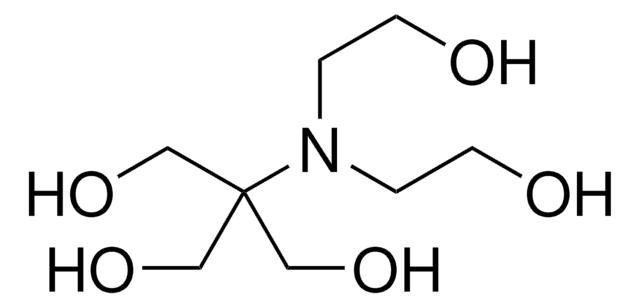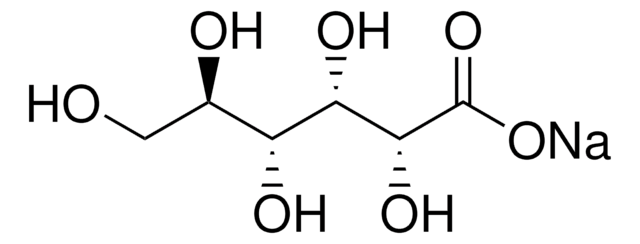T9784
Tricina
BioXtra, pH 4.0-6.0 (1 M in H2O), ≥99% (titration)
Sinônimo(s):
N-[Tris(hidroximetil)metil]glicina
About This Item
Produtos recomendados
linha de produto
BioXtra
Nível de qualidade
Ensaio
≥99% (titration)
forma
powder
Impurezas
≤0.005% Phosphorus (P)
≤0.1% Insoluble matter
resíduo de ignição
≤0.1%
pH
4.0-6.0 (1 M in H2O)
faixa de pH útil
7.4-8.8
pKa (25 °C)
8.1
solubilidade
H2O: 1 M, clear, colorless
traços de ânion
chloride (Cl-): ≤0.1%
sulfate (SO42-): ≤0.05%
traços de cátion
Al: ≤0.0005%
Ca: ≤0.0005%
Cu: ≤0.0005%
Fe: ≤0.0005%
K: ≤0.005%
Mg: ≤0.0005%
NH4+: ≤0.05%
Na: ≤0.005%
Pb: ≤0.001%
Zn: ≤0.0005%
absorção
≤0.05 at 280 in H2O at 1 M
≤0.1 at 260 in H2O at 1 M
aplicação(ões)
diagnostic assay manufacturing
cadeia de caracteres SMILES
OCC(CO)(CO)NCC(O)=O
InChI
1S/C6H13NO5/c8-2-6(3-9,4-10)7-1-5(11)12/h7-10H,1-4H2,(H,11,12)
chave InChI
SEQKRHFRPICQDD-UHFFFAOYSA-N
Procurando produtos similares? Visita Guia de comparação de produtos
Descrição geral
Aplicação
- in a polymerase chain reaction (PCR) buffer used in the single-cell collection
- as a component of lactotroph feeding medium for culturing lactotrophs
- to prepare luciferase assay reagent for luciferase activity assay in firefly Photonis pyralis and as a component in Triton/glycylglycine lysis buffer
Não está encontrando o produto certo?
Experimente o nosso Ferramenta de seleção de produtos.
Código de classe de armazenamento
13 - Non Combustible Solids
Classe de risco de água (WGK)
WGK 3
Ponto de fulgor (°F)
Not applicable
Ponto de fulgor (°C)
Not applicable
Equipamento de proteção individual
Eyeshields, Gloves, type N95 (US)
Certificados de análise (COA)
Busque Certificados de análise (COA) digitando o Número do Lote do produto. Os números de lote e remessa podem ser encontrados no rótulo de um produto após a palavra “Lot” ou “Batch”.
Já possui este produto?
Encontre a documentação dos produtos que você adquiriu recentemente na biblioteca de documentos.
Os clientes também visualizaram
Nossa equipe de cientistas tem experiência em todas as áreas de pesquisa, incluindo Life Sciences, ciência de materiais, síntese química, cromatografia, química analítica e muitas outras.
Entre em contato com a assistência técnica





